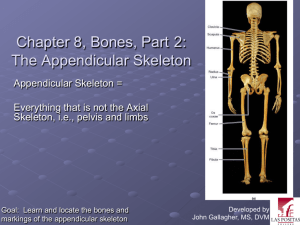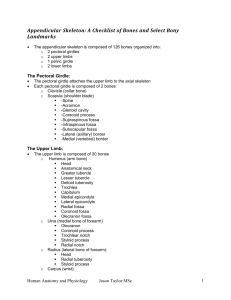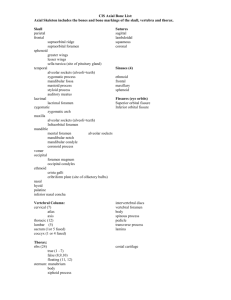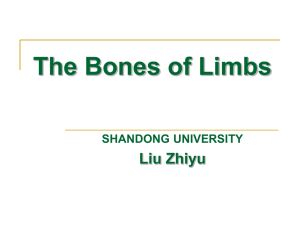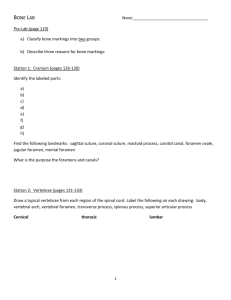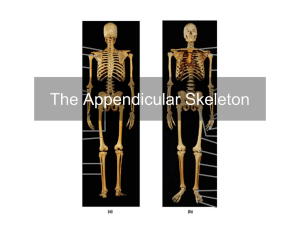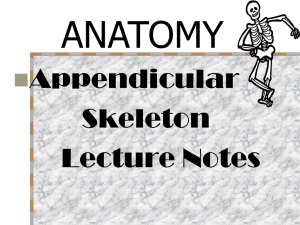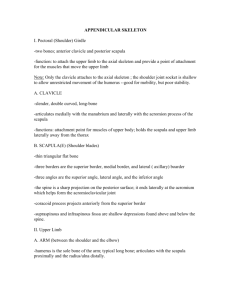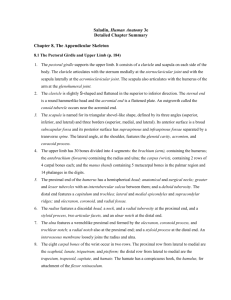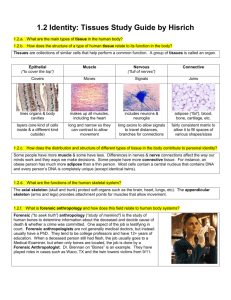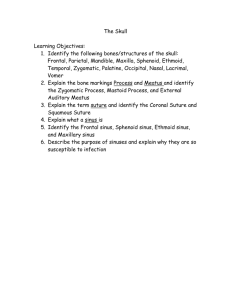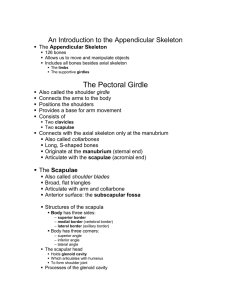The Appendicular Skeleton
advertisement
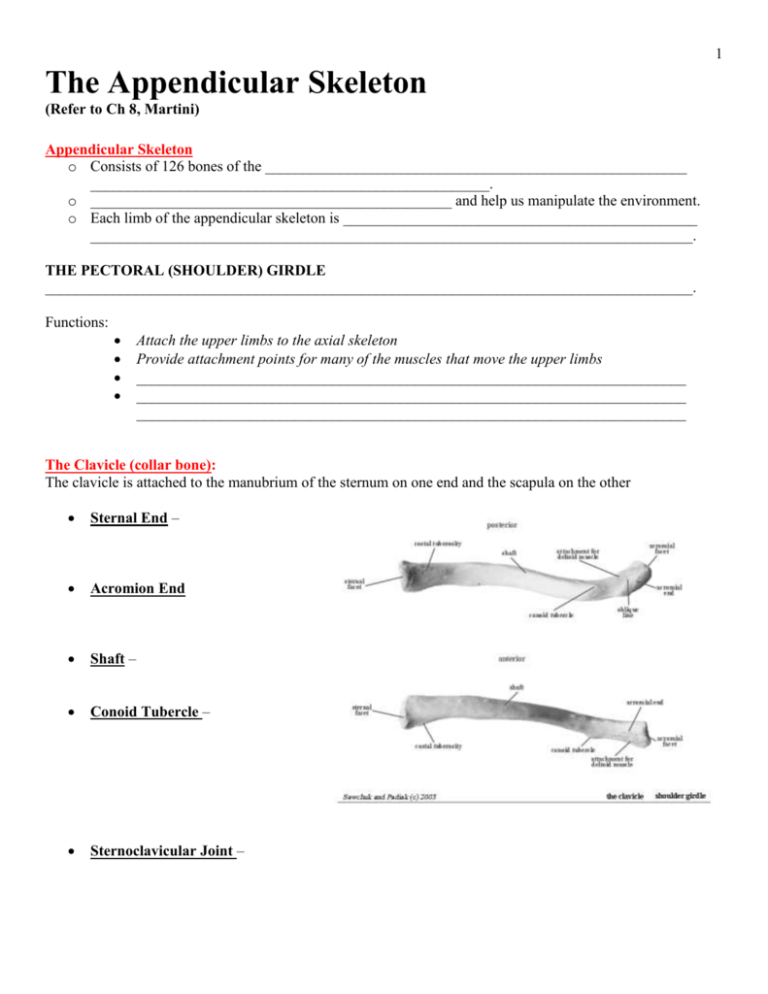
1 The Appendicular Skeleton (Refer to Ch 8, Martini) Appendicular Skeleton o Consists of 126 bones of the ________________________________________________________ _____________________________________________________. o ________________________________________________ and help us manipulate the environment. o Each limb of the appendicular skeleton is _______________________________________________ ________________________________________________________________________________. THE PECTORAL (SHOULDER) GIRDLE ______________________________________________________________________________________. Functions: Attach the upper limbs to the axial skeleton Provide attachment points for many of the muscles that move the upper limbs _________________________________________________________________________ _________________________________________________________________________ _________________________________________________________________________ The Clavicle (collar bone): The clavicle is attached to the manubrium of the sternum on one end and the scapula on the other Sternal End – Acromion End Shaft – Conoid Tubercle – Sternoclavicular Joint – 2 Functions: Provides attachment points for many muscles _______________________________________________________________ (this function is very well illustrated during a clavicle fracture in which the shoulder collapses medially) The clavicle is extremely sensitive to muscle pull and as according to Wolff’s Law is noticeably larger in individuals who lift weights or perform manual labor. The Scapula (shoulder blades): Acromion Process that connects the clavicle as well as several muscles and ligaments Coracoid Process – and anchors the clavicle and some of the muscles and ligaments of the arm. Glenoid Cavity/Fossa – Scapular Spine – Supraspinous Fossa – Infraspinous Fossa – Subscapular Fossa – Acromioclavicular Joint – Glenohumeral Joint – Be able to also locate the following: Superior angle, inferior angle, lateral angle (head), body, superior border, medial (vertebral) border, and lateral (Axillary) border ________________________________________________________________________________________ ________________________________________________________________________________________ In comparison to the hip joint, the pectoral girdle has exceptional flexibility but is very easily dislocated. 3 Superior Border (Axillary) (Vertebral) THE UPPER LIMBS There are 30 bones per upper limb, humerus through the phalanges. The Humerus (upper arm): The proximal end (head) of the humerus Greater tubercles and lesser tubercles – Intertubercular Groove – Deltoid tuberosity – The condyle is composed of the medial trochlea and the lateral capitulum. Coronoid fossa (anterior) and the olecranon fossa (posterior) – found at the distal end of the humerus – Anatomical Neck – 4 Surgical Neck – Radial Groove – Medial Epicondyle – (epi = above) Lateral Epicondyle – Radial Fossa – Funny Bone – a blow at the posteromedial surface of elbow strikes ulnar nerve creating numbness in the anterior forearm 5 The Radius and Ulna (forearm): ULNA: forms elbow with the humerus and is found on the little finger (medial) side of the wrist. Coronoid Process – Olecranon Process – o Together these processes ______________________________________ in a pliers-like joint. Trochlear (Semilunar) Notch – separates the coronoid and olecranon processes; Ulnar Head – Radial Notch – (forms Proximal Radioulnar Joint) Styloid Process of Ulna – located on medial aspect of distal ulna; Ulnar Tuberosity – RADIUS: _____________________________________________________________________________ Head of Radius: located on proximal end of radius; Radial Tuberosity – Radial Neck – Styloid Process of Radius - located on lateral aspect of distal radius; 6 Ulnar Notch – (forms Distal Radioulnar Joint) Interosseous Membrane – 7 The Carpals, Metacarpals, and Phalanges (hand): There are 8 marble sized short bones called the carpals, which are arranged in two rows of four bones and form the carpus (wrist). Each of these bones has an individual name. Proximal Carpal Bones: __________________, _____________________, _____________________, ____________________ Distal Carpal Bones: __________________, _____________________, _____________________, ____________________ Sam likes to push the toy car hard; some like to ponder that this class hard The 5 metacarpals form the palm of the hand. _________________________________________________ _______________________________________________________________________________________ _______________________________________________________________________________________ Metacarpal #1 is associated with your thumb and has ___________________________________________ _______________________________________________. This allows your thumb to be used in opposition (the opposing thumb) to your other fingers. There are 14 miniature long bones called the phalanges that make up the human fingers. Each finger has 3 phalanges, except for the thumb (________) which has 2. The names of the three phalanges are proximal, middle, and distal. (Phalanx is the singular term for phalanges.) 8 THE PELVIC GIRDLE (HIP) Functions: Attaches the lower limbs to the lower end of the axial skeleton _______________________________________________________________________________ Provides a surface for muscles to attach Supports the visceral (internal) organs of the pelvis _______________________________________________________________________________ ___________________________________________________ A pair of irregularly shaped hipbones called the coxal bones forms the pelvic girdle. _______________________________________________________________________________________. The three individual bones are the ilium, ischium, and pubis. The Ilium: superior section of the coxal bone The ilium is the largest bone of the pelvis; Attachment of muscles, tendons, and ligaments Sacroiliac Joint – Iliac Crest.- Anterior Superior Iliac Spine & Anterior Inferior Iliac Spine Posterior Superior Iliac Spine & Posterior Inferior Iliac Spine – Anterior, Posterior and Inferior Gluteal Lines– Auricular Surface – (of ilium) – Iliac Tuberosity – Iliac Fossa – Arcuate Line (ilium) – Greater Sciatic Notch – 9 The Ischium: forms posterior, inferior coxal bone The ischium (is’ke-um) forms the most inferior part of the coxal bone. Ischial Tuberosity – Ischial Spine – Lesser Sciatic Notch – Ischial Ramus – The Pubis: forms anterior, inferior coxal bone The pubis fuses with the ischium to form a bar of bone enclosing the obturator foramen. Obturator Foramen – Pubic Symphysis – Acetabulum - The ilium, ischium, and pubis fuse at the Acetabulum, Lunate Surface of Acetabulum – Pubic Tubercle – Superior and Inferior Pubic Ramus – Pectineal Line – 10 Pubic Arch (Pubic Angle) – 11 The pelvis provides an easy way to distinguish between the skeletons of a male and a female. The female pelvis reflects modifications for childbearing. In comparison to the male pelvis, the female pelvis: _________________________________________________________________________________________ _________________________________________________________________________________________. True Pelvis – False Pelvis – Pelvic Girdle – Pelvis – Pelvic Brim – Pelvis Inlet – Pelvis Outlet – 12 THE LOWER LIMBS Functions: Carry the weight of the entire upper body Provides attachment for the muscles of the legs The Femur (thigh): Largest, longest, & strongest bone in the body (length is roughly ¼ of a person’s height) Head – Fovea Capitis – Neck - Greater Trochanter - Lesser Trochanter Intertrochanteric Crest – Intertrochanteric Line – Lateral Epicondyles – Medial Epicondyles – Lateral Condyles – Medial Condyles – Gluteal Tuberosity – Intercondylar Fossa – Shaft of Femur – that fits in acetabulum of coxal bone 13 Patellar Surface – Linea Aspera – Popliteal Surface – posterior distal femur surface; Medial and Lateral Supracondylar Ridges – 14 The Patella (knee): Patella – The patellae are cartilaginous at birth. Ossification begins at age 2-3 and ends roughly by the time of puberty The Tibia and Fibula (lower leg): The tibia and fibula are much less flexible yet more stable than the ulna and radius of the forearm. The tibia (shinbone) forms the knee joint with the femur, and also forms the ankle joint with the bones of he foot. The tibia can be felt through the thin layer of skin for the entire length of the lower leg. It is only second to the femur in strength and size. Lateral Condyles – Medial Condyles – Intercondylar Eminence – Tibial Tuberosity – Medial Malleolus – Anterior Margin (also known as the Anterior Crest or Border) – ; easily felt through the skin Inferior Articular Surface of the Tibia Malleolar Articular Surface of the Tibia – Superior Tibiofibular Joint – 15 Inferior Tibiofibular Joint – FIBULA: The fibula only provides support for the ankle and does not assist in the joint of the knee. The fibula does not bear weight, but does have many muscles attached to it. Fibular Head – Neck – Lateral Malleolus – Interosseous Membrane – Malleolar Articular Surface of the Fibula – 16 The Tarsals, Metatarsals, and Phalanges (foot): Functions of the Foot: Supports our body weight Acts as a lever to propel our body forward as we walk or run If we had only one bone in our foot, we could still propel our body in the same fashion, however, we would not be able to adapt so well to uneven ground. The tarsus (ankle) is composed of 7 tarsals that are more irregular shaped than the carpals, and there are more size differences among them. (Refer to page 141) Most of the body weight is carried on the largest two tarsals, the calcaneus (heel bone) and the talus (lies between tibia and calcaneus). Trochlea of Talus – __________________, __________________, __________________, __________________, _____________________________, _____________________________, _____________________________, The metatarsals are composed of 5 small long bones. They are not named, but are numbered using Roman Numerals I-V beginning with the big toe side of the foot. #1 is the shortest and thickest metatarsal. The 14 phalanges of the toes are much smaller than those of the fingers. There are three phalanges within each toe except the big toe. The phalanges of each toe are proximal, middle, and distal, with the big toe missing the middle phalanx. Hallux – ________________________ Arches The bones in the foot are arranged to form three arches; two _________________________ (medial and lateral) and one ________________ (Refer to Figure 5.24). The ligaments and tendons of the foot hold the bones in place and allow a certain amount of give to maintain the arches.
